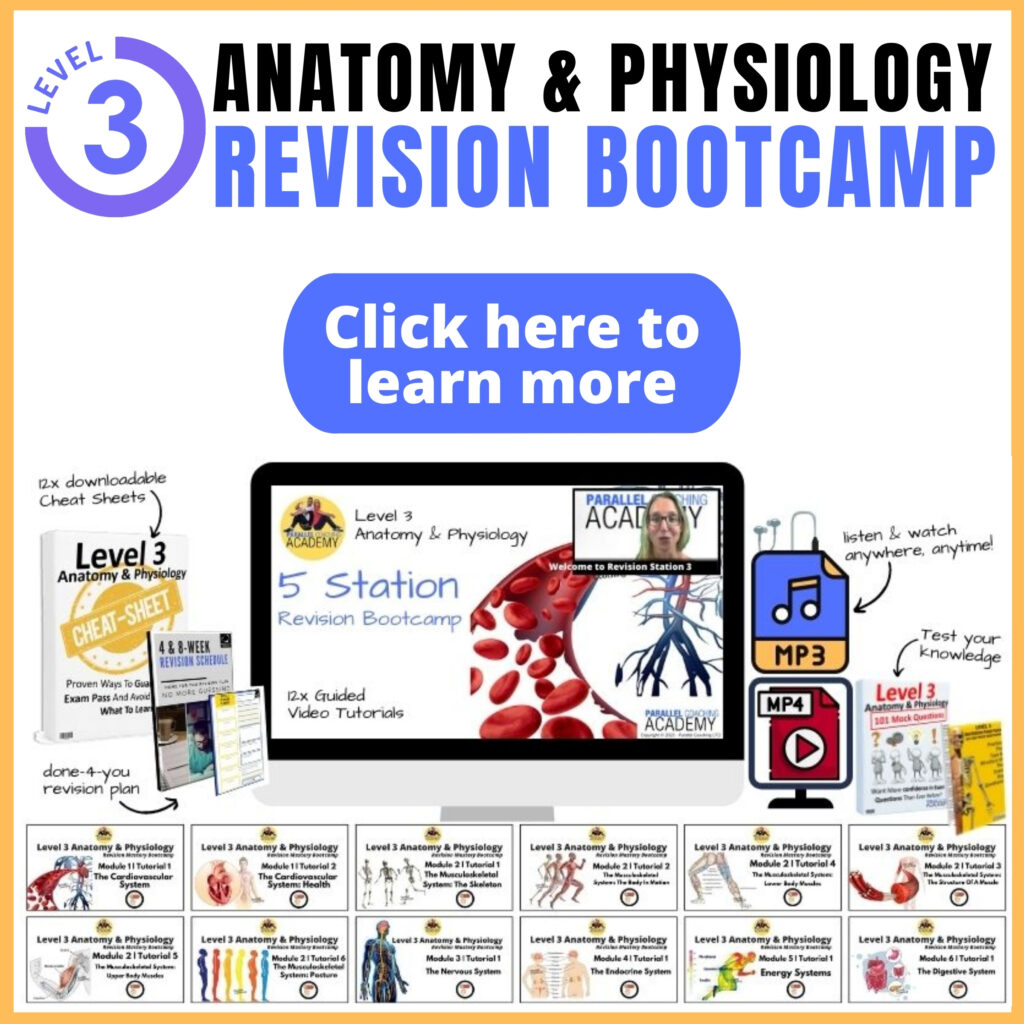This blog will teach you the difference between all three Axes of Movement in preparation for your Level 3 anatomy and physiology exam
You’ll discover:
- Why FitPros find Axes of Movement hard to revise
- A 6 mins Video Tutorial teaches you all about Axis of Movement
- Understanding the 3 Axes of Movement in relation to the Planes of Movement
- How to learn with simplicity for the rest of the modules
- Three Example Mock Questions about the Joint Actions
Why FitPros find the Axes of Movement hard to revise
The axes of movement are notoriously claimed to be one of the hardest modules within Level 3 Anatomy and Physiology exam syllabus, so you are not alone if you find this area difficult to understand.
Unlike other areas of anatomy (like bones), it can be hard to make sense of the movement and dimensions from an image in a manual. It may also feel like this is less directly related to training clients as a FitPro.
Although you might not actually be quoting the technical axes of movement terms with your clients, the knowledge of this is foundational and absolutely crucial in order to create balanced workout plans and understand how the body moves.
What are the Axes of Movement?
Good question. There are 3 Axes of movement
Anterior-Posterior Axes:
- This is like having a skewer through your belly button, running between the front of you and the back of you
- Actions include Lateral Flexion and Extension, Adduction and Abduction
- All of these movements are in the Frontal Plane
Medial-Lateral Axes:
- This is like having a skewer through your sides like a FoosBall player
- Actions include Flexion and Extension, Dorsiflexion and Plantarflexion
- All of these movements are in the Sagittal Plane
Longitudinal Axes:
- This is like having a skewer vertically down through the centre of you like in a hog roast, or how a ballerina in a jewellery box rotates around a spike
- Actions include Rotation, Horizontal Flexion and Extension and Internal and External rotation
- All of these movements are in the Transverse Plane
6 mins Video Tutorial: How To Remember Axes of Movement
In this 6 minute video you’ll learn all 3 axes of movement and quick tips on how to remember them.
Axis of Movement and Planes of Movement are Related
READ THE FOLLOWING VERY CAREFULLY AND TAKE NOTE.
THIS IS FUNDAMENTAL FOR YOUR EXAM
Sagittal Plane movements occur around a Medial-Lateral Axis
Frontal Plane movements occur around an Anterior-Posterior Axis
Transverse Plane Movements occur around a longitudinal Axis.
In summary:
- Axis and planes of movement are different, however, they certainly relate.
- This module of the “Body In Motion” will come up in your Level 3 Anatomy and Physiology exam.
- Knowing the 3 axes of movement will be key as you can expect 4 to 6 exam questions around this module.
- Here’s what Lydia had to say about the A&P Revision Bootcamp
I can’t recommend Parallel Coaching enough their learning material is fantastic and definitely was a huge factor in me passing my A&P level 3.
Lydia
Test your knowledge with today’s Axes of Movement mock questions:
[NOTE: The answers are below the 3rd questions]
1. During Hip Flexion which Axes of Movement is the hip moving around?
A. Anterior-Posterior
B. Medial- Lateral
C. Sagittal
D. Transverse
2. All transverse plane movements occur in which axes of movement?
A. Longitudinal
B. Anterior-Posterior
C. Sagittal
D. Rotation
3. During a Dumbbell Lateral Raise which axes is the shoulder joint moving around?
A. Medial-Lateral
B. Sagittal
C. Anterior-Posterior
D. Frontal
What’s the CORRECT answer?
Answers to the mock questions are :
Question 1= B, Question 2 = A, Question 3 = C
If you want more mock questions like this, then you can download more Free Mock Questions: DOWNLOAD NOW
Need More Help with your Level 3 Anatomy Revision?
or Trainee FITPROS Taking Their L3 Anatomy & Physiology Exam.
Learn, Revise & Pass Your Level 3 Anatomy & Physiology Exam In Under 10-hours
(Without Having To Spend Hours Revising Or Feeling Overwhelmed)
If you want to get your revision structured, learn everything you need to know and feel confident on exam day, then click the link below:
https://courses.parallelcoaching.co.uk/products/level-3-anatomy–physiology-revision-bootcamp

Dedicated to More
Hayley “What are the 3 Axes of Movement?” Bergman
Parallel Coaching
P.S. You can also find us on the following platforms:
Instagram: Follow Now
Facebook: Like Our Page
Twitter: Tweet Us
YouTube: Subscribe Here
More Axis of movement Blogs: HERE

